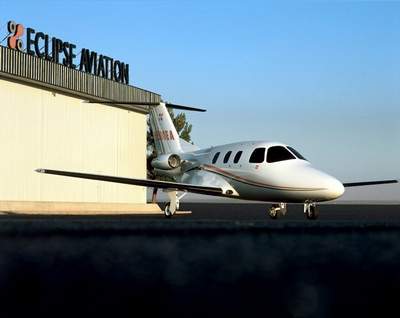 Setbacks, major and minor, are part
of any development program, and the greater the technology leap,
the greater the expectation of such setbacks. Time is built into
any realistic development program, to help absorb such setbacks.
That time is well-used by some, and squandered by others.
Setbacks, major and minor, are part
of any development program, and the greater the technology leap,
the greater the expectation of such setbacks. Time is built into
any realistic development program, to help absorb such setbacks.
That time is well-used by some, and squandered by others.
Eclipse has had less than its anticipated share of such
problems, but even that organization proves the rule. The decision,
made last year, to dump the Williams EJ-22 engines was one of the
"major" setbacks. "Possibly two years" seems to be the concensus
that the decision seems to have cost. The decision to continue with
the engines, though, could have ruined the whole program. Last
week, the starboard landing gear collapsed, to give an example of
the "minor" category of setback.
Nevertheless, Vern Raburn and his team in Albuquerque are
steaming at flank speed, developing as circumstances dictate, and
basically trying to stay ahead of the airplane... and they're doing
it.
At Oshkosh, we were treated to some actual production looks at
the new tiny twinjet, as a conforming fuselage was displayed in its
lovely green primer. CEO Vern Raburn took us through it: "We make
the fuselage in three sections, starting with the belly." That
allows all kinds of structure to go in, followed by controls,
cabling and other necessities, while the fuselage is still "open."
Then, Mr. Raburn said, "We position the top two halves."
The approach Eclipse has taken is to use each pause in the
planned production to its advantage. A reevaluation of power led to
the choice of stronger Pratt & Whitney turbines; and any delay
can be used to enhance what's already happening.
Training, for instance:
 Eclipse, from the
beginning, has known that training is an essential part of changing
the paradigm of personal flight. Eclipse's Don Taylor, who has been
setting up world-class training for what is actually years, is in
tune with Vern Raburn, and vice versa. Raburn told us that
Eclipse's belief is that "Training will become more type-specific."
What about the idea, popular not long ago, that some "industry
standard" or regulation to standardize cockpit layouts, would make
flying easier and better? "If you try to standardize," Raburn
explained, "you stifle innovation."
Eclipse, from the
beginning, has known that training is an essential part of changing
the paradigm of personal flight. Eclipse's Don Taylor, who has been
setting up world-class training for what is actually years, is in
tune with Vern Raburn, and vice versa. Raburn told us that
Eclipse's belief is that "Training will become more type-specific."
What about the idea, popular not long ago, that some "industry
standard" or regulation to standardize cockpit layouts, would make
flying easier and better? "If you try to standardize," Raburn
explained, "you stifle innovation."
Further, the recent trend toward teaching increasingly-complex
systems has, Raburn opined, also taken time away from basic
stick-and-rudder flying skills. Flying 'to the numbers' has perhaps
made better-reacting pilots; but have pilots learned to not get
into nasty situations in the first place, as they negotiate
weather, terrain, traffic, and poor visibility? "We reject the
concept that you cannot teach judgment," Raburn said, flatly.
Flight Test
Last week's gear failure resulted in little damage, but will put
a few days' delay in the flight test program. Even Vern Raburn had
a tough time putting a positive spin on the incident, but managed
to say, "The best I can say is, 'we validated some [failure]
modes.'" He added, "Now we know, for instance, that we have aileron
control down to 30 knots." That could be important, especially for
(really) slow-flight exercises. More-importantly, Eclipse is
getting right back on track. "We should be flying late this week,"
Vern said on Wednesday.

The company has about 18 hours' flying on the interim-engined
personal jet. "Those are really maybe 100-hour engines," Vern
explained, "and we get a lot of data and telemetry from each
flight. Fifty hours max -- that's all we plan to fly it... maybe
less."
 ANN's Daily Aero-Term (05.05.24): Omnidirectional Approach Lighting System
ANN's Daily Aero-Term (05.05.24): Omnidirectional Approach Lighting System Aero-News: Quote of the Day (05.05.24)
Aero-News: Quote of the Day (05.05.24) Airborne 05.06.24: Gone West-Dick Rutan, ICON BK Update, SpaceX EVA Suit
Airborne 05.06.24: Gone West-Dick Rutan, ICON BK Update, SpaceX EVA Suit Airborne 05.03.24: Advanced Powerplant Solutions, PRA Runway Woes, Drone Racing
Airborne 05.03.24: Advanced Powerplant Solutions, PRA Runway Woes, Drone Racing Aero-News: Quote of the Day (05.06xx.24)
Aero-News: Quote of the Day (05.06xx.24)





